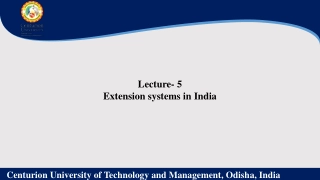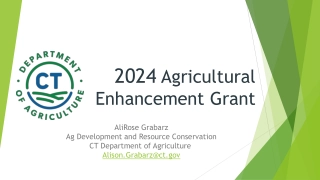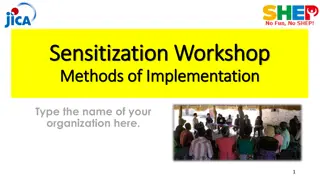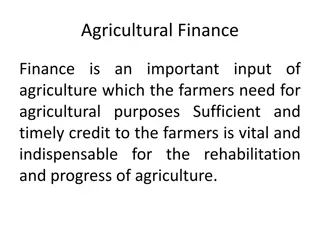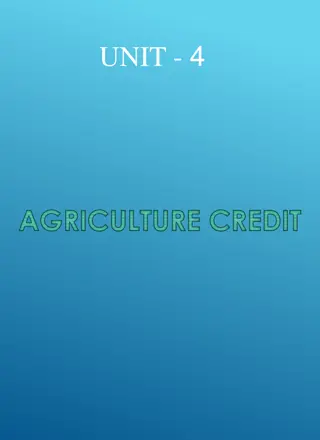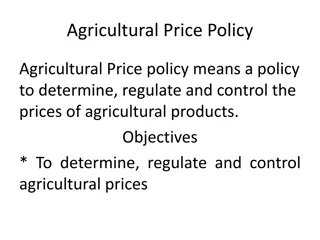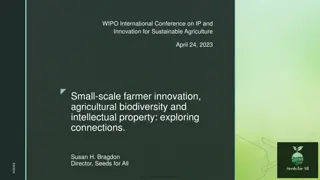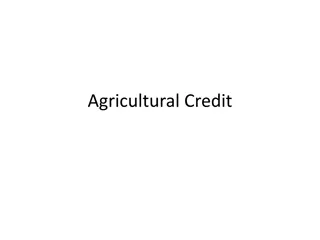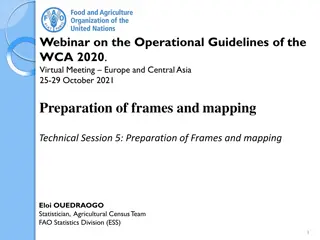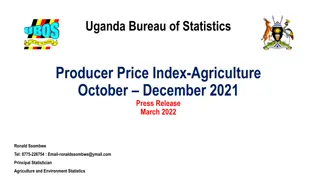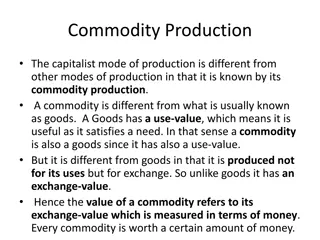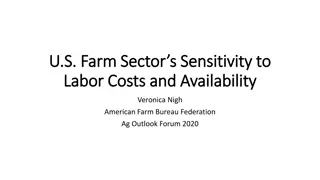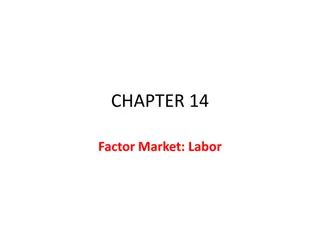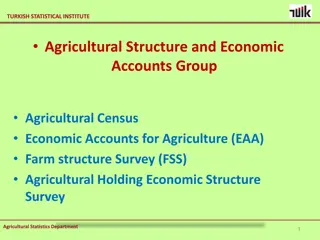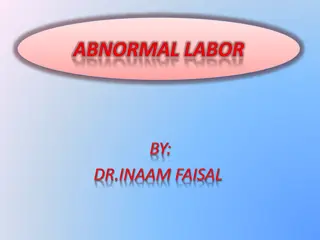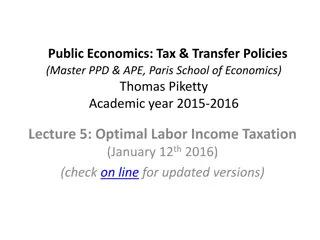CUAB 2327 Agri Technology Management
Agricultural technology, also known as agrotechnology or agtech, is revolutionizing farming practices through the application of modern scientific and technological innovations. Discover the challenges in the agricultural sector and the importance of agricultural technology in enhancing productivity
4 views • 15 slides
Lecture- 5. Extension systems in India
Explore the evolution and impact of agricultural extension systems in India, including initiatives like the National Agricultural Technology Project (NATP), Agriculture Technology Management Agency (ATMA), and the National Mission on Agriculture Extension and Technology (NMAET). These programs aim t
0 views • 10 slides
Agricultural Enhancement Grant Program Overview
The Agricultural Enhancement Grant Program provides funding for projects that support agricultural viability in Connecticut. Eligible applicants include municipalities, regional councils of governments, and agricultural non-profit organizations. Projects addressing specific focus areas can receive g
3 views • 38 slides
Agricultural Roads Improvement Program Overview
The Agricultural Roads Improvement Program (ARIP) is a one-time grant initiative funded with $150 million to improve deteriorating Class B and weight-restricted roads hindering agricultural operations. Eligible projects must provide access to agricultural lands, involve agricultural producers, and a
5 views • 7 slides
Challenges and Trends in Agricultural Valuations and Regulations
Exploring the complexities of agricultural valuations and regulations in European countries, this content delves into the diversity of agriculture across different regions. It discusses the challenges faced in understanding farmland markets, the impact of new factors like climate change, and the imp
8 views • 14 slides
Understanding Agricultural Risk Management in the Face of Natural Disasters
Exploring the impact of natural disasters on agricultural economics, this content delves into the challenges faced by farmers and the approaches available for managing risks. From analyzing the Billion-Dollar Disasters in the US to discussing private and public risk management provisions, the conten
3 views • 20 slides
Implementing Sensitization Workshops for Agricultural Development
This content provides a detailed guide on conducting Sensitization Workshops for agricultural development, focusing on steps, objectives, and implementation methods. The workshops aim to raise awareness, empower farmers, and enhance skills for self-reliance. Key aspects covered include sharing goals
0 views • 13 slides
Overview of Agricultural Finance: Importance, Classification, and Sources
Agricultural finance is crucial for the development of agriculture, providing farmers with the necessary resources for various purposes such as purchasing inputs, managing risks, and improving land. It is classified into short-term, medium-term, and long-term credit based on loan periods, catering t
0 views • 37 slides
Understanding Agricultural Credit: Definition, Need, and Classification
Agricultural credit involves obtaining money for farming activities with a promise to repay in the future. It plays a crucial role in facilitating agricultural production by providing financial resources from external sources. The definition, need, and classification of agricultural credit are explo
0 views • 11 slides
Understanding Agricultural Price Policy and Its Importance
Agricultural price policy plays a crucial role in determining, regulating, and controlling prices of agricultural products. Its objectives include preventing violent price fluctuations, ensuring fair prices for farmers, and integrating prices across regions. The policy aims to provide remunerative p
2 views • 33 slides
Agricultural Policy Developments in Kosovo - Progress and Challenges
The Covid-19 pandemic has posed financial stability risks in Kosovo. The agricultural sector saw positive growth in 2020, but progress in agricultural and rural development programs remains limited. Urgent measures are needed to prevent the loss of agricultural land and align legislation with EU sta
0 views • 12 slides
Overview of Labor Law and Union Formation Process
Labor law governs the structure and operations of private labor relations in the United States. The National Labor Relations Act (NLRA) establishes the National Labor Relations Board (NLRB) to handle unfair labor practices in the private sector. The process of forming a union involves reaching out t
0 views • 11 slides
Economics of Labor Markets: Factors of Production and Labor Demand
The Economics of Labor Markets explores the markets for factors of production such as labor, land, and capital. Demand for these factors is derived from firms' decisions to produce goods. The labor market, governed by supply and demand forces, exhibits diminishing marginal product of labor due to fi
0 views • 41 slides
Strategies for Enhancing Agricultural Markets in India
Dr. S.P. Yadav proposes various measures to enhance agricultural marketing in India, including establishing regulated markets, developing marketing societies, improving infrastructure facilities, and ensuring timely access to credit and market information for farmers. Additional steps involve formul
0 views • 5 slides
Small-Scale Farmer Innovation and Agricultural Biodiversity in the Context of Intellectual Property
Discussions at the WIPO International Conference on IP and Innovation for Sustainable Agriculture highlighted the crucial role of small-scale farmers in managing and developing agricultural biodiversity, which is essential for sustainable agricultural production and global food security. The session
1 views • 12 slides
Understanding Agricultural Credit and Its Importance in Farming
Agricultural credit plays a crucial role in supporting farmers by providing financial assistance for various needs such as purchasing inputs, implements, managing risks, improving land, enhancing product marketing, and facing crises. Different types of agricultural credit include short-term and medi
0 views • 15 slides
Understanding Unfair Labor Practices vs. Grievances at FLRA, NLRB, and DC PERB
Unfair labor practices (ULPs) are violations of federal labor laws, while grievances involve disputes between labor organizations and agencies. Different reviewing authorities handle these matters: FLRA for federal, NLRB for private sector, and DC PERB for DC government agencies. Each organization h
0 views • 47 slides
Livestock: Key Driver for Sustainable Agricultural Development
Livestock plays a crucial role in sustainable agricultural development by driving land use, consumption, and serving as a powerful engine for food systems. The focus on livestock is essential for exploring pathways towards Sustainable Agricultural Development (SAD) and addressing challenges related
1 views • 24 slides
Supporting Agricultural Cooperatives Development Project
This European Union-funded project, implemented by CARE and MEDF, aims to enhance productivity and competitiveness in the agricultural sector by fostering cooperation and market competitiveness among farmers through the establishment and growth of agricultural cooperatives. Key activities include re
0 views • 11 slides
A Vision for Excellence in Agricultural Education, Communications, and Leadership
Dr. Jonathan Ulmer, a Professor of Agricultural Education at Kansas State University, envisions creating a world-class department focused on excellence in agricultural education, communications, and leadership. With comprehensive experience in academia and agricultural education, the department offe
0 views • 26 slides
Accounting for Biological Assets and Agricultural Produce (LKAS 41: Agriculture) by Rangajewa Herath
This content provides insights into the accounting standards for biological assets and agricultural produce under LKAS 41, discussing classification, presentation, measurement, gain or loss recognition, and disclosure requirements. It covers the unique nature of biological assets, the scope of LKAS
0 views • 20 slides
Development of Methodologically Robust Agricultural Capital Stock Statistics by FAO
In November 2015, the Food and Agriculture Organization of the United Nations (FAO) initiated a project to enhance Agricultural Capital Stock statistics, focusing on inclusive and efficient agricultural and food systems. The project involves developing methodologies for measuring capital stock and m
0 views • 38 slides
Operational Guidelines of the WCA 2020 Agricultural Census Frame Preparation
The webinar focuses on the preparation of frames and mapping for the Operational Guidelines of the WCA 2020 in the Europe and Central Asia region. It covers the definition of frames, types of frames, sources of information, guidelines for building frames, requirements for different census modalities
0 views • 33 slides
Uganda Bureau of Statistics Producer Price Index - Agriculture Overview
The Uganda Bureau of Statistics (UBOS) produces and disseminates the Producer Price Index Agriculture to show the farm-gate prices received by farmers for primary agricultural products. The index is used by various stakeholders for policy-making and decision-making purposes. It covers key agricultur
2 views • 26 slides
Understanding Commodity Production and Labor in Capitalist Mode
The capitalist mode of production is characterized by commodity production, where goods are produced not for their use but for exchange. The value of a commodity is determined by its exchange value, measured in money, which is influenced by the quantity of labor involved in its production. Labor, be
0 views • 8 slides
Agricultural Opportunities and Food Security in Kazakhstan
Kazakhstan offers vast opportunities in agribusiness with 200 million hectares of agricultural lands, prioritizing access to major international markets like China and Russia. The country aims to increase labor productivity, boost domestic food production, and enhance rural residents' income through
0 views • 8 slides
Understanding the Significance of Agriculture Economics in India
Agriculture plays a crucial role in the Indian economy, contributing significantly to GDP and rural livelihoods. Agriculture Economics involves the study of resource allocation in the production, distribution, and consumption of agricultural goods. This branch of economics blends principles from gen
0 views • 24 slides
Comprehensive Guide to the Management of Normal Labor by Professor Muhsin-AL-Sabbak
Understanding the management of normal labor is crucial for healthcare professionals. This comprehensive guide covers the definition of normal vaginal delivery, diagnosis of labor, stages of labor, phases of labor, and the use of tools like partogram and cardiotocography to monitor progress. Profess
0 views • 9 slides
Physiology of Labor: Onset and Key Hormonal Changes
Labor, or parturition, involves uterine contractions leading to the fetus's expulsion. Factors triggering labor include hormonal changes like increased estrogen and decreased progesterone, which stimulate uterine muscle activity. Telocytes play a role in spontaneous uterine activity, while oxytocin
0 views • 36 slides
Migration Policies and Labor Laws in Russia: A Comprehensive Overview
Irina Foret, PhD, an associate professor at Voronezh State University, delves into the legal status of foreigners in Russia, including work visas, labor rights violations, and legal remedies. Key aspects such as Article 62 of the Constitution and Article 11 of the Labor Code are discussed, highlight
0 views • 30 slides
U.S. Farm Sector's Sensitivity to Labor Costs and Availability
Agriculture labor is a significant expense for farmers, with a growing demand for labor that is geographically concentrated and time-sensitive. Challenges arise in the form of a challenging immigration system and increased enforcement threats. The H-2A Temporary Agricultural Worker Program serves as
0 views • 18 slides
Impacts of Labor Productivity by Age and Changes in Age Structure on Labor Productivity in Vietnam
This research focuses on quantifying the impact of labor productivity by age on the overall economy's labor productivity in Vietnam. Utilizing analytical methods like the Cobb-Douglas production function and Shift-Share Analysis, the study aims to understand how changes in age structure and labor sh
0 views • 26 slides
Induction of Labor: Methods and Considerations
Induction of labor is done to achieve vaginal delivery before spontaneous onset, usually at 39 weeks or when medically necessary. Risks include failed induction, cesarean section, uterine rupture, prolonged labor, and infections. Cervical ripening methods help prepare the cervix for labor. The Bisho
0 views • 18 slides
Understanding Competitive Factor Market in Labor Economics
A competitive factor market involves a large number of sellers and buyers of a factor of production, like labor. With no single entity influencing prices, each acts as a price taker. The demand for factors depends on firms' output levels and input costs, leading to derived demands. Profitability of
0 views • 43 slides
Supporting Access to Agricultural Insurance Through Regulation and Supervision
Enhancing wider access to index-based agricultural insurance is crucial in Africa due to the significant risks faced in the agricultural sector. This presentation by Dr. Grace Muradzikwa, Commissioner of Insurance, Pension, and Provident Funds, highlights the role of regulation and supervision in ad
0 views • 18 slides
Understanding Labor Productivity Growth in Europe: Insights from Productivity Project Conference
Divergent experiences in labor productivity growth between the US and Europe have sparked interest in analyzing factors affecting productivity. The Productivity Project Conference in January 2015 delved into macro and micro-level determinants of labor productivity, focusing on Total Factor Productiv
1 views • 27 slides
Department of Employment and Labour: Vision, Mandate, and Objectives
The Department of Employment and Labour aims to regulate the labor market through policies focusing on economic efficiency, decent employment, labor standards, and social safety nets. The department's vision is to create a conducive labor market for investment, economic growth, employment, and decen
0 views • 35 slides
Agricultural Census by Turkish Statistical Institute
The Turkish Statistical Institute conducts agricultural censuses to collect data on agriculture's structure, land use, irrigation, livestock, and other agricultural aspects. Through surveys and studies, the institute aims to provide essential agricultural data, facilitate comparisons, and update fra
1 views • 14 slides
Understanding Abnormal Labor and Prolonged Labor in Childbirth
Labor is considered abnormal when there is poor progress or signs of compromise in the fetus. Prolonged labor, lasting more than 18 hours, may result from various factors affecting cervical dilatation and descent of the presenting part. Causes include issues with power, passage, and passenger. Diagn
0 views • 20 slides
Optimal Labor Income Taxation: Main Theoretical Results and Intuitions
The optimal taxation of labor income involves a U-shaped pattern of marginal tax rates, with top rates influenced by income concentration and labor supply elasticities. Mirrlees' model analyzes optimal labor income taxes based on productivity and labor supply decisions, aiming to maximize social wel
0 views • 24 slides

